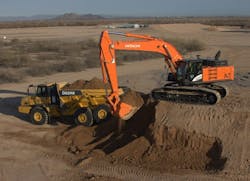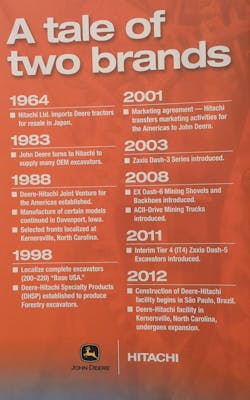What the Deere-Hitachi Split Means for Managers
When two companies come together to do business in this industry, the end result is often one swallowing up the other, or a short-lived combination with an awkward new name that eventually becomes a historical footnote: future fodder for a Construction Equipment “Iron Works” column.
With John Deere and Hitachi, the result was a mutually beneficial joint venture focused on excavators that lasted more than three decades and helped both companies achieve excavator market share in North America. Deere was able to use advanced Hitachi product designs, a strong Deere dealer network gave Hitachi added distribution nationwide, and factories in the Americas churned out years of Deere- and Hitachi-branded machines.
In August, Deere and Hitachi Construction Machinery America (HCMA) issued simultaneous PR-heavy statements announcing the partnership would be dissolved on February 28.
John Deere will acquire the Deere-Hitachi joint-venture factories in Kernersville, North Carolina; Indaiatuba, Brazil; and Langley, British Columbia, Canada. Deere will continue to manufacture Deere-branded construction and forestry excavators currently produced at the three factories. These locations will no longer produce Hitachi-branded excavators. Deere will continue to offer a full portfolio of excavators through a multiyear supply agreement with Hitachi, including the two largest Deere-branded excavators (670G, 870G) and the compact, reduced-tail-swing models and wheeled models currently produced in Japan.
John Deere’s marketing arrangement for Hitachi-branded construction excavators and mining equipment in the Americas will end; Hitachi will assume distribution and support for these products.
“We’re both very grateful for the partnerships; I don’t think Deere in the earthmoving space would be where it is today without the partnership with Hitachi,” says Domenic Ruccolo, Deere’s SVP, sales, marketing, and product support, Global Construction Equipment and chief sales officer, Wirtgen Group.
“And I think Hitachi’s excavator volume in North America wouldn’t be where it is without Deere being part of the journey,” Ruccolo says. “I think we shattered all records in terms of partnerships between two companies, two OEMs in the construction equipment space, so I think ‘mission accomplished’ from that standpoint.”
Moving forward, the two companies will now have more control over their respective excavator lines—and the technology within—and Hitachi will have to form a new distribution network.
“There’s no doubt that Deere has done a great job exposing customers to the Hitachi excavator product line, and we really appreciate that,” says Al Quinn, CEO, HCMA. “The real challenge for us is now we want to give our customers the opportunity to buy [machines] directly through Hitachi. We believe that we’ve got even more to offer than what customers have seen in the past.
“The distribution change that Hitachi is going to go through is really major,” Quinn says. “Of course, we’ve got Canada, we’re really well represented by Wajax all across Canada, and they’ve had Hitachi excavators and loaders together for about four years now. On the U.S. side, probably the best news that I’ve received since the dissolution is the amount of interest that has come forward from either existing players who are ready to double down and re-invest now that the future for Hitachi is clear, but also new investors.
Above: Customers didn’t always understand the Deere-Hitachi joint venture. This is a trade show banner explaining joint venture milestones that was displayed at ICUEE 2013.
“There are a lot of people who are interested in investing in the construction equipment market,” Quinn says. “It’s a mature market, there are not going to be a lot of new competitors coming in, and Hitachi with the brand recognition and worldwide commitment is viewed as a great new player, almost, in this market.”
Quinn says Hitachi has been making calls to potential dealers as well as receiving calls. “We may not be able to cover everywhere on day one, but what will happen is that we’re going to see a whole new group of tier one dealers that may surprise some people.”
On the Deere side, Ruccolo says customers will not notice a difference in sales and support.
“We’ve had a number of discussions with customers, dealers, you name it, in explaining that we’re [still going to be] there. Perhaps the easiest way to say it is they asked after the announcement, ‘What’s changed?’ and the answer is really ‘nothing.’”
Ruccolo says there has been some confusion about the dissolution of the joint venture contributing to delays in machine delivery. “A big thing is kind of decoupling those two issues,” he says. “There’s a supply issue that’s driven by high demand, supplier challenges, the pandemic and everything else, and then there’s this [question] ‘Where is our JV and supply agreement going?’ [It’s] a little bit of apples and oranges, but once we explained that to them, they clearly understood and I’d say right now our dealers are very excited about the future and the prospects of Deere controlling its destiny in the excavator business.”
The ability to control the development of different technologies was an impetus to dissolving the joint venture.
Telematics-wise, the two manufacturers have different systems: JDLink for Deere and ConSite for Hitachi. “We have JDLink, and they have their system, which they’ve incorporated into wheel loaders, but it’s tough to have two systems in the same machine, right?” Ruccolo says. “It’s not possible. If you go back at the start of this [JV], there was no telematics for anyone. Machines were far simpler, but there’s the advent of technology....[I]f you look at today in terms of grade control, obstacle detection, just a number of other technologies that are emerging, it’s going to be more and more difficult to reach agreement with anyone on that because our platform is driven from things through our Smart Industrial Strategy within the broader Deere enterprise. And [then] there’s the stuff that they’ve developed within Hitachi.”
Quinn also points out divergence in the development of technologies.
“As we develop breakthroughs in one market or in one segment, it now becomes a lot easier for us to go ahead and roll it out here,” Quinn says. “It’s not a matter of trying to coordinate with a different partner who might have limitations on the engine they provide, or having to re-engineer to make sure that you’re getting the right kind of linkages. So, it allows us to make sure that we’re maximizing the use of everything we’ve got.”
Hitachi is choosing to take a more direct route to customers with machine information. “What we’ve done with ConSite is create troubleshooting pages that can go to the dealers, and even to the customer, so that there’s a step-by-step troubleshooting analysis that’s completed as well as repair estimates—how much it’s going to cost for the parts and what you would see for the labor,” Quinn says. “Is it going to be covered under warranty or is it going to be customer pay? So, we’re really trying to establish the support centers here through our regional head office to carry it through the dealers and directly to the customer.
“I don’t know enough about what’s behind Deere’s [telematics] to support [this statement], but I’d say we’re taking more of a direct ownership of the information and rolling that information out versus trying to push it on the dealers to do it,” Quinn says. “We think that we can be more effective taking that leadership position.”
Quinn admits there are cost advantages manufacturing exclusively in Japan for now, particularly for West Coast distribution, and there have been fewer supply chain problems. “The factory has been meeting delivery expections,” he says. “We’ve had a few shipping problems, but they’ve been more unique, like a boat breaking down.” Extensions into new size classes or moves to new product categories do not seem to be on the horizon.
Ruccolo says that while the supply agreement allows the three Deere factories to continue making Hitachi-designed Deere-branded excavators, Deere has an opportunity to extend Deere excavator designs the company has been executing the last 14 years. “Over time, the agreement provides us enough flexibility to, on a model-by-model basis, replace those [Hitachi-designed units] with Deere-designed excavators.”
Quinn is genuinely excited for Hitachi to go it alone in North America. He says the company sought to hire 70 people for its Newnan, Georgia, location and received 750 applicants.
“Our expectation is on March 1, you’re going to see an orange blossom,” he says. “We’re ready to move.”

